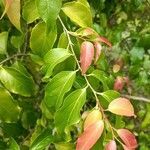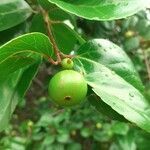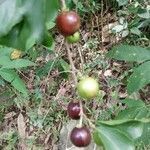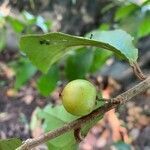Small, deciduous tree, 6-10(-14) m; trunk and branches commonly thornless in old trees, +-densely beset with simple or branched, woody thorns when younger; bark light-brown to copper-red or pinkish-buff, flaky into thin lamels; young branches white-dotted by numerous suborbicular lenticels, puberulous or mostly glabrous. Leaves ± narrow-ovate to ovate-oblong, rarely ovate-lanceolate, long-obtuse-acuminate, broadly cuneate to rounded at the base, membranous to thinly chartaceous (pinkish or light cinnamon-brown when young in a fresh state), glabrous, shining above, mostly dull beneath, subserrate-crenate, (5-)7-10(-11) ny (2-)3-4(-5.5) cm; petiole puberulous or glabrescent, 6-8 mm. Racemes axillary, subcorymbose, glabrous, few-flowered, the ♂ 1½-3, the female 1-1.5 cm long. Flowers fragrant of honey, before or with the young foliage. Pedicels very slender, 0.5-1(-1.5) cm. Sepals 4(-5), ovate, obtuse, greenish, ± pubescent on both sides, 2 mm. Disk fleshy, entire or slightly lobed, white or yellow (orange). ♂ Flowers: filaments glabrous. ♀ Flowers: Ovary first flask-shaped, soon sub-globular, with 4-6 styles connate into a distinct, 1 mm high column, not or slightly free at their apices, each bearing a ± dilatate, bilobed, recurved stigma. Fruit subglobose, 1.5-2.5 cm diam., dull-brownish red or purple, then blackish, with greenish-yellow pulp, enclosing 4-5(-10) flat seeds, tipped with the single, short style-column with 4-6 minute stigma-points.
Tree to 10 (–14) m high, usually deciduous; young trees with woody thorns, older trees usually unarmed; branchlets puberulous or glabrous, with suborbicular lenticels. Leaves alternate; lamina ovate-lanceolate to narrowly ovate-oblong, mostly 7–10 cm long, 3–4 cm wide (5–14 cm long and 2–5.5 cm wide, in litt.), broadly cuneate to rounded at base, serrate-crenate to crenulate margin, rounded to acuminate at apex, membranous or chartaceous, shiny above, glabrous except midvein; secondary veins 4–6 pairs; petiole 6–8 mm long, puberulous or glabrescent; stipules minute. Racemes axillary, few-flowered, subcorymbose, puberulous or glabrous, 1.5–3 cm long in males, 0.5–1 cm in females. Sepals 4, rarely 5, somewhat pubescent on both sides, ovate, obtuse, 2 mm long. Disc fleshy, entire or lobed. Male flowers: stamens 20–60, 3–4 mm long; filaments glabrous. Female flowers: ovary glabrous, flask-shaped, with 4–6 connate styles 1 mm long; stigmas bilobed, recurved. Fruit subglobose, 1.5–2.5 cm diam., dark reddish purple with greenish yellow pulp, 4–6-ribbed when dry. Seeds 4 or 5, rarely more. See also Cooper & Cooper (2004), Zich et al. (2020).
A small deciduous tree up to 10 m tall. It spreads to 3 m across. The stem is erect and branching. Young tree parts can have large branched spines. The leaves are 5-10 cm long and 2-4 cm wide. Young leaves are red and glossy. There are several flushes of new growth during the year. Old trees often do not have thorns on the trunk or branches. Flowers are small and in clusters in the axils of leaves. They have a strong sweet smell. The fruit is a dull brownish red with a greenish yellow pulp. Fruit are about 2 cm across.






